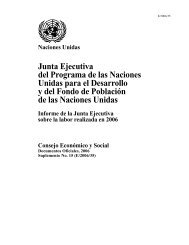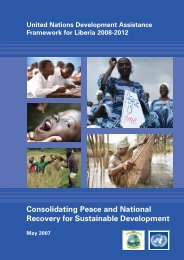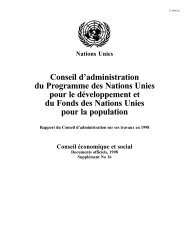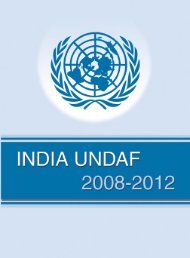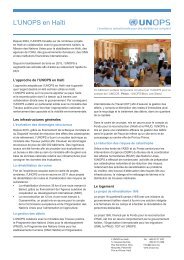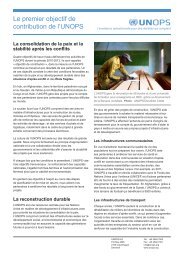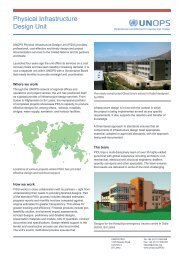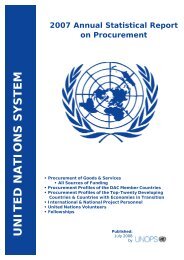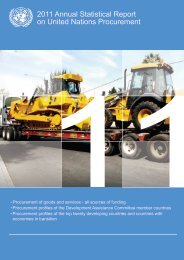Sustainable Procurement supplement - UNOPS
Sustainable Procurement supplement - UNOPS
Sustainable Procurement supplement - UNOPS
You also want an ePaper? Increase the reach of your titles
YUMPU automatically turns print PDFs into web optimized ePapers that Google loves.
2008 Annual Statistical Report<br />
on United Nations <strong>Procurement</strong><br />
<strong>Sustainable</strong> procurement <strong>supplement</strong><br />
• <strong>Sustainable</strong> procurement is making its mark at the UN<br />
• Case studies from South Africa, China and Indonesia<br />
• Looking ahead: balancing environmental, social and economic objectives
Supplement to the 2008 Annual Statistical Report<br />
on United Nations <strong>Procurement</strong><br />
<strong>UNOPS</strong> would like to acknowledge the contribution of the various authors<br />
to this <strong>supplement</strong> to the 2008 Annual Statistical Report on United Nations<br />
<strong>Procurement</strong>. The views expressed in this publication are not necessarily shared<br />
by each of the authors. Furthermore, the views expressed in this publication are<br />
those of the authors and do not necessarily reflect those of the United Nations.<br />
Copyright © 2009<br />
All rights reserved. No part of this publication may be reproduced, stored<br />
in a retrieval system or transmitted, in any form by any means, electronic,<br />
mechanical, photocopying or otherwise, without prior permission of <strong>UNOPS</strong>.<br />
This document is available online at www.ungm.org. It has been published in<br />
electronic format only thereby eliminating the use of paper, ink, and transport<br />
emissions.
Foreword<br />
We live in a time of unprecedented global challenges, when<br />
vision and action to protect our planet are needed as never before.<br />
This is why I am so pleased to introduce this publication on<br />
sustainable procurement.<br />
Two years ago on World Environment Day, I called on United Nations agencies to join me in moving the UN toward climate<br />
neutrality and toward more sustainable management operations. Today, I am pleased to see we have taken some important<br />
steps in this direction. I welcome the efforts undertaken by several UN agencies, funds and programmes to find new ways of<br />
making sustainability part of our everyday work.<br />
<strong>Sustainable</strong> procurement and operations is one such example. Together, we are continuing to use this market-based tool to<br />
reduce harmful impacts.<br />
However, much more needs to be done – and soon. The world’s leading scientists warn that the climate is changing faster than<br />
predicted due to the continued increase in global greenhouse gas emissions. Building a more sustainable, low-carbon economy<br />
is a matter of scientific urgency. But it is also an opportunity to invest in the clean energy sources of the future, expand energy<br />
access, protect development gains, and build more climate-resilient societies.<br />
Action is needed at all levels – from Heads of State and Government to national and municipal authorities, the business<br />
community and local citizens’ organisations. As this report makes clear, promising initiatives are emerging everywhere,<br />
including many in the developing world.<br />
In this “year of climate change,” I am urging the United Nations family to take further steps towards overall sustainability by<br />
greening our procurement and aligning it to the highest ethical standards of the organization.<br />
We must lead by example and become a greener, more environmentally responsible organization. We have no time to lose, and<br />
much to gain for this and future generations.<br />
Ban Ki-moon<br />
Secretary-General of the United Nations<br />
1 | 2008 Annual Statistical Report on <strong>Procurement</strong>
Contents<br />
Introduction.......................................................................................................................................................... 3<br />
The UN High Level Committee on Management’s <strong>Procurement</strong> Network approach to sustainable procurement<br />
Michael Cora ................................................................................................................................................... 4<br />
Public procurement: a tool for promoting more sustainable consumption and production patterns<br />
Mónica Kjöllerström, UNDESA ..................................................................................................................... 6<br />
Buying social justice: using public procurement to advance social, ethical and human rights goals<br />
Christopher McCrudden .................................................................................................................................. 9<br />
<strong>Sustainable</strong> procurement in South Africa<br />
Incite Sustainability.......................................................................................................................................... 11<br />
Greening government procurement in developing countries: Building capacity in China<br />
Yong Geng and Brent Doberstein..................................................................................................................... 14<br />
<strong>Sustainable</strong> public procurement in Indonesia<br />
Suzy Rizki Sadikin........................................................................................................................................... 16<br />
<strong>Sustainable</strong> procurement: looking ahead<br />
Dr Helen Walker............................................................................................................................................... 18<br />
2 | 2008 Annual Statistical Report on <strong>Procurement</strong>
Introduction<br />
The theme of this <strong>supplement</strong> to the Annual Statistical Report<br />
on UN <strong>Procurement</strong> 2008 is sustainable procurement. The<br />
aim of the <strong>supplement</strong> is to provide an overview of the<br />
current debate on sustainable procurement, and on the latest<br />
policy development in this emerging field.<br />
The concept of sustainable procurement is closely connected<br />
to sustainable development. It promotes consumption<br />
patterns that are mindful of environmental impacts,<br />
beneficial to the society at large and economically sound.<br />
<strong>Sustainable</strong> procurement is the most complete definition<br />
for these practices, however many other terms are used,<br />
such as sustainable public procurement, ethical purchasing,<br />
sustainable supply chain management and ethical supply.<br />
Green procurement – also called environmental procurement,<br />
green purchasing, eco-procurement or green government<br />
procurement – is not synonymous with sustainable<br />
procurement, but rather a sub-concept that refers to the<br />
environmental dimension only. The term socially responsible<br />
procurement, used less frequently, is also a sub-concept used<br />
to indicate purchasing practices that advance social values.<br />
This publication is introduced by UN Secretary-General Ban<br />
Ki-moon, highlighting the key role that procurement has to<br />
play in promoting and facilitating sustainable development.<br />
Next Michael Cora – chair of the UN procurement network,<br />
the HLCM PN – describes the rapid progress of many UN<br />
agencies towards the creation of a policy framework and<br />
the practical implementation of sustainable procurement.<br />
Following these articles, a general introduction to sustainable<br />
procurement is provided by Mónica Kjöllerström, of<br />
the United Nations Department of Economic and Social<br />
Affairs (UNDESA). Next, the social aspect of sustainable<br />
procurement is discussed in an article by Professor<br />
Christopher McCrudden, where it is argued that sustainable<br />
procurement can be a legitimate and effective means of<br />
achieving social justice.<br />
A series of case studies in developing countries follow.<br />
Jonathon Hanks and Incite Sustainability present the recent<br />
developments of sustainable procurement in South Africa.<br />
Professors Yong Geng and Brent Doberstein emphasize the<br />
potential contribution of green procurement in addressing<br />
environmental issues in China. Susy Rizki Sadikin traces the<br />
early developments of the sustainable procurement practice<br />
in Indonesia – especially through the use of ecolabels – and<br />
discusses potential benefits for the achievement of the goal of<br />
sustainable development in the country.<br />
Finally Professor Helen Walker explores emerging issues in<br />
the sustainable procurement policy agenda.<br />
3 | 2008 Annual Statistical Report on United Nations <strong>Procurement</strong>
The UN High Level Committee on<br />
Management’s <strong>Procurement</strong> Network<br />
approach to sustainable procurement<br />
— Michael Cora<br />
Michael Cora is the Chairperson of the UN High Level Committee on Management’s <strong>Procurement</strong> Network (HLCM PN). He is also the Director of<br />
UNESCO’s <strong>Procurement</strong> Division. Dealing with procurement since 1983, in four different UN agencies and various geographical locations has made him<br />
conversant with all aspects of modern purchasing, including the principles, policies and practices of sustainable procurement.<br />
<strong>Procurement</strong> in the United Nations exceeded $13 billion<br />
in 2008. This annual procurement volume represents<br />
a significant market to the business communities in<br />
industrialized and developing countries, as well as those in<br />
economies in transition. Today, procurement is called upon to<br />
bring its contribution to another challenge: that of supporting<br />
the sustainable development objectives of the international<br />
community through sustainable procurement.<br />
Two interagency mechanisms are collaborating on<br />
sustainable procurement and share a common programme<br />
of work: the UN High Level Committee on Management’s<br />
<strong>Procurement</strong> Network (HLCM PN) and the Environment<br />
Management Group (EMG). The latter operates through the<br />
<strong>Sustainable</strong> UN Initiative (SUN) anchored in the United<br />
Nations Environment Programme (UNEP) and ensures the<br />
links between the two groups.<br />
This partnership fits within existing work on efficiency<br />
and effectiveness of the purchasing function within the<br />
UN system. It works through collaborative arrangements,<br />
simplification and harmonization of procurement procedures<br />
and practices, and by fostering professionalism amongst the<br />
staff involved in procurement proceedings. <strong>Procurement</strong><br />
experts from thirty one organizations participate in the<br />
implementation of this programme of work. At the Network’s<br />
bi-annual meetings, these organizations are represented by<br />
their high-level procurement managers as well as experts<br />
from EMG and the UNEP SUN Initiative for the sustainable<br />
procurement related discussions.<br />
Defining how sustainable procurement is interpreted within<br />
the UN family is fundamental if we are to ensure that we<br />
speak a common language, and that this language reflects our<br />
values. Therefore, one of the first tasks for the HLCM PN in<br />
addressing this issue was providing the community of UN<br />
agencies with a definition of what we mean by sustainable<br />
procurement, together with a policy statement to guide our<br />
collective action.<br />
Thus, we agreed in February 2009 that:<br />
<strong>Sustainable</strong> procurement practices integrate requirements,<br />
specifications and criteria that are compatible with and<br />
in favour of the protection of the environment, of social<br />
progress and in support of economic development, namely<br />
by seeking resource efficiency, improving the quality of<br />
products and services and ultimately optimizing costs.<br />
Furthermore, sustainable procurement bases its choice of<br />
goods and services on:<br />
• economic considerations: such as value for money,<br />
life-cycle costs, quality, availability, functionality and<br />
innovation;<br />
• environmental aspects (green procurement): meaning the<br />
impacts on the environment that the product and/or service<br />
has over its whole life-cycle; and<br />
• social aspects: from the consideration of human rights,<br />
labour conditions and employees’ health and insurance,<br />
small and medium enterprises and local vendors, to the<br />
ban of companies involved in child labour and military<br />
production (landmines in particular).<br />
It is important to note that the definition adopted by the<br />
HLCM PN encompasses all three pillars of sustainable<br />
development, and that it highlights pro-developmental<br />
aspects. Consequently, sustainable procurement should not<br />
be considered a market distortion or a barrier to competition,<br />
but rather a valuable tool to develop markets and capabilities.<br />
Furthermore, public opinion is about to change and the<br />
beneficiaries of our services are more and more sensitive to<br />
sustainability aspects, thus forcing us to change as well.<br />
The HLCM PN relies on the cooperation among agencies<br />
and organizations – a mechanism that has been working<br />
outstandingly for the development of our sustainable<br />
procurement know-how. We have combined UNEP expertise<br />
in sustainable consumption and production together with the<br />
procurement skills of organizations such as <strong>UNOPS</strong> and the<br />
UN <strong>Procurement</strong> Division. We have started joint initiatives<br />
with the EMG to ensure consistency with the UN Climate<br />
Neutrality objective. Results achieved through this collective<br />
effort are quite impressive.<br />
4 | 2008 Annual Statistical Report on United Nations <strong>Procurement</strong>
© ITC ILO/C. Rubiano<br />
To advance sustainable procurement, the number of training sessions will be expanded to reach a higher number of procurers within the UN.<br />
The priority for HLCM PN action so far has been to create an<br />
enabling environment to favour sustainable procurement and<br />
climate neutrality interventions in the procurement processes<br />
of the UN system. The adoption of a common definition<br />
is part of this effort, as is the drafting of a <strong>Sustainable</strong><br />
<strong>Procurement</strong> Statement that defines our commitment.<br />
The EMG and the SUN Initiative on the other hand<br />
concentrated their work on the provision of practical tools<br />
and capacity building. A series of <strong>Sustainable</strong> <strong>Procurement</strong><br />
Product Guidelines have been developed and tested in several<br />
UN locations around the world. They have been produced to<br />
facilitate the inclusion of sustainability aspects in UN tenders<br />
and sustainable procurement training courses. A Guide to<br />
Environmental Labels for <strong>Procurement</strong> Practitioners has<br />
jointly been released. These resources, together with many<br />
others, have been gathered in the <strong>Sustainable</strong> <strong>Procurement</strong><br />
Knowledge Centre, on the online platform of the UN Global<br />
Marketplace and on the EMG and UNEP SUN websites.<br />
Finally, we want to be able to capture the extent of our efforts<br />
and measure our results; this is why from this year onwards<br />
the Annual Statistical Report on UN <strong>Procurement</strong> will<br />
contain a sustainability reporting section.<br />
The working programme for the advancement of sustainable<br />
procurement in the next months is intensive. Besides<br />
the expansion of the <strong>Sustainable</strong> <strong>Procurement</strong> Product<br />
Guidelines series to include other frequently purchased<br />
products, the HLCM PN, the EMG and SUN are about to<br />
finalize a <strong>Sustainable</strong> <strong>Procurement</strong> Guide and a training<br />
module on sustainable procurement for requisitioners. At the<br />
same time, the number of training sessions on sustainable<br />
procurement is going to be expanded to reach a higher<br />
number of procurers within the UN.<br />
Ample attention is and will continue to be devoted to the<br />
expansion of sustainable procurement in developing countries<br />
and those with economies in transition. This all helps to<br />
highlight how they can benefit from this practice. Here,<br />
one of the main challenges of sustainable procurement is<br />
the harmonization of environmental and social concerns<br />
with a fair and equal access to the UN procurement market.<br />
Significant progress has been made and we are quite proud<br />
to report that the volume of orders awarded to suppliers from<br />
developing countries and those with economies in transition<br />
has exceeded 50 percent since 2006.<br />
Concerns have been voiced that sustainable procurement<br />
might disturb this balance. To respond, the HLCM PN, the<br />
EMG and SUN have adopted a very mindful approach.<br />
In particular, we have been very firm in highlighting that<br />
sustainable procurement is not about ‘burdening’ the market<br />
with extra requirements. Rather is it a well-defined strategy<br />
that gradually phases in sustainable requirements in bids<br />
and promotes dialogue and open communication between<br />
suppliers and procurers.<br />
Even though, the immense efforts and the progress made are<br />
well visible, we are still at the beginning of a long road. But<br />
we will go forward in a new, practical and – most of all –<br />
sustainable way.<br />
5 | 2008 Annual Statistical Report on United Nations <strong>Procurement</strong>
Public procurement: a tool for<br />
promoting more sustainable<br />
consumption and production patterns<br />
— Mónica Kjöllerström, UNDESA<br />
This article is a summary of the <strong>Sustainable</strong> Development Innovation Brief written by Mónica Kjöllerström and previously published by the Division for<br />
<strong>Sustainable</strong> Development of the United Nations Department of Economic and Social Affairs (UNDESA). The original brief can be accessed at<br />
http://www.un.org/esa/dsd/resources/res_pdfs/publications/ib/no7.pdf.<br />
A significant share of the world’s gross domestic product<br />
(GDP) is associated with expenditures by governments.<br />
On average, total public expenditures by central and local<br />
governments - including consumption and investment<br />
expenditures - are estimated to account for about 20 percent<br />
of GDP in Organisation for Economic Co-operation and<br />
Development (OECD) countries, and roughly 15 percent<br />
in non-OECD countries. Governments have increasingly<br />
become involved in making their procurement ‘greener’ or<br />
more sustainable.<br />
Why should governments engage in sustainable<br />
procurement?<br />
The first reason to get involved in sustainable procurement<br />
is based on cost effectiveness. Some ‘greener’ products and<br />
services are less costly in terms of their use, maintenance<br />
and disposal despite higher upfront investment costs. A<br />
second reason is that governments, due to their importance<br />
as customers in some markets, can make a difference in<br />
environmental outcomes by choosing environmentally<br />
friendly options. A third reason, which is directly linked to<br />
the second one, is that governments can use their market<br />
power to influence producers to shift more rapidly to cleaner<br />
technologies. Lastly, public demand for more sustainably<br />
produced goods and services can also have desirable<br />
indirect effects, such as raising consumer awareness about<br />
the environmental and social implications associated with<br />
different types of purchases.<br />
<strong>Sustainable</strong> procurement policies at the country level<br />
Countries in both developed and developing regions have<br />
used public procurement to pursue social goals - to reduce<br />
unemployment, raise labour standards, provide employment<br />
opportunities for disabled persons, and promote gender, racial<br />
and ethnic equality. In the mid-1990s, various governments<br />
started taking steps towards adopting green procurement.<br />
Since then, there has been considerable progress, although<br />
full implementation at the central government level remains<br />
limited to some countries (see Figure 1).<br />
What is sustainable procurement?<br />
Environmentally responsible or ‘green’ procurement is the selection of products and services that minimize<br />
negative environmental impacts. It requires a government or organization to carry out an assessment<br />
of the environmental impacts of a product at all the stages of its lifecycle. This means considering the<br />
environmental costs of securing raw materials, and manufacturing, transporting, storing, handling, using and<br />
disposing of the product.<br />
<strong>Sustainable</strong> procurement incorporates social considerations along with environmental impacts. As defined<br />
by the UK <strong>Sustainable</strong> <strong>Procurement</strong> Task Force in 2006, sustainable procurement is a process “whereby<br />
organizations meet their needs for goods, services, works and utilities in a way that achieves value for money<br />
on a whole life basis in terms of generating benefits not only to the organization, but also to society and the<br />
economy, whilst minimizing damage to the environment.”<br />
6 | 2008 Annual Statistical Report on United Nations <strong>Procurement</strong>
Figure 1:<br />
Using public<br />
procurement<br />
to achieve<br />
environmental<br />
goals: some<br />
country examples<br />
Canada<br />
A policy on green procurement issued in April 2006 requires that<br />
environmental performance considerations be embedded into the<br />
procurement decision-making process in the same manner as<br />
price, performance, quality and availability. Guidelines, toolkits<br />
and training have been made available to facilitate this process.<br />
It is estimated that three quarters of government departments or<br />
agencies had green purchasing policies in place as of 2006/2007.<br />
Japan<br />
The 2000 Law on Promoting Green Purchasing makes it<br />
compulsory for government institutions to implement green<br />
procurement, while encouraging local authorities, private<br />
companies and individuals to make efforts for purchasing<br />
environmentally sound products and services. All state ministries,<br />
departments and agencies have to define procurement targets<br />
every fiscal year and make the results of green procurement<br />
efforts publicly available. 90 percent of central government<br />
agencies implement green procurement. Although by 2005 all<br />
sub-national governments had developed procurement policies,<br />
implementation has been slower.<br />
European Union<br />
By early 2007, 9 out of 26 EU member-states had adopted<br />
national sustainable or green procurement action plans, five had<br />
drafted a national action plan but it had not yet been adopted,<br />
and two were in the process of preparing one. In Austria,<br />
Denmark, Finland, Germany, Netherlands, Sweden and the UK,<br />
40 to 70 per cent of all tenders published on Tenders Electronic<br />
Daily incorporated some environmental criteria, although in the<br />
remaining 18 countries, this figure was below 30 percent.<br />
United States<br />
A 2007 Executive Order integrates and updates prior practices<br />
and requirements with the goal of increasing federal purchasing of<br />
energy efficient, recycled content, biobased, and environmentally<br />
preferable products and services. Federal agencies must also<br />
ensure that: at least half of renewable energy comes from new<br />
renewable sources; water consumption is reduced by two percent<br />
annually through 2015; fleet total petroleum consumption is<br />
reduced by two percent annually; use of alternative fuels is<br />
increased by 10 percent a year and plug-in hybrid vehicles are<br />
used when available at reasonable costs.<br />
Brazil<br />
Proof of the legality of the source of wood used in public<br />
construction and infrastructure projects is required by law. More<br />
broadly, a 2007 bill establishes that public purchases should take<br />
environmental criteria into consideration whenever possible.<br />
Argentina<br />
Argentina has developed an action plan to implement sustainable<br />
procurement, and carried out research and training activities for<br />
procurement officials and policy-makers with the support of the<br />
Marrakech Task Force on sustainable procurement.<br />
Mexico<br />
The 2007-2012 National Development Plan created the scope<br />
for changes in procurement policy that allow for the incorporation<br />
of sustainability criteria. Recent changes in procurement law<br />
in Mexico include the requirement that all wood and furniture<br />
purchased by public agencies possess a certificate demonstrating<br />
its legal origin (since September 2007) and paper should have at<br />
least 50 percent recycled content.<br />
China<br />
From January 2007, the central government and provincial<br />
governments are asked to give priority to environment-friendly<br />
products listed in a ‘green product inventory’. The list, released<br />
in late 2006, includes products ranging from cars to construction<br />
materials that have been approved by the China Certification<br />
Committee for Environmental Labelling. Products are required to<br />
meet the environmental protection and energy saving<br />
standards set by the State Environmental Protection<br />
Administration in order to obtain the environmental label.<br />
Republic of Korea<br />
The Act on the Promotion of the Purchase of Environment-<br />
Friendly Products, passed in 2005, requires public agencies<br />
at national and local levels to publish green procurement<br />
policies and implementation plans, carry out the latter, and<br />
report results. The Environment Ministry is asked to publish<br />
guidelines, designated items and evaluation criteria. Although<br />
green public procurement is still relatively small (roughly 6<br />
percent of total public procurement in 2003), it has been<br />
growing very rapidly during recent years.<br />
7 | 2008 Annual Statistical Report on <strong>Procurement</strong>
At the subnational level, a wide array of initiatives is under<br />
way. In the USA, actions to reduce greenhouse gas emissions<br />
are widespread among cities throughout the country. In<br />
Europe, a large number of cities apply environmental<br />
criteria in the purchase of electricity, food, furniture, IT<br />
equipment, cleaning products, paper, construction, timber and<br />
transport. In Belgium and the Netherlands, several municipal<br />
governments require that contractors recruit the long-term<br />
unemployed and several local governments in Italy use Fair<br />
Trade specifications in procuring food products for public<br />
school canteens.<br />
In Japan, green procurement activities were first led by<br />
civil society organizations, local authorities and companies,<br />
culminating in the establishment of the Green Purchasing<br />
Network in 1996, with the support of the Ministry of<br />
Environment. <strong>Procurement</strong> initiatives are also multiplying<br />
at the state level in federal states such as Brazil, Mexico, the<br />
USA, and Canada.<br />
Potential obstacles to sustainable procurement<br />
implementation<br />
An obstacle to the implementation of sustainable procurement<br />
can be the legal framework. More than half of the OECD<br />
countries that responded to a survey carried out in 2007<br />
modified their legislation in order to introduce environmental<br />
criteria into public procurement. The budget and accounting<br />
frameworks under which public institutions operate, which<br />
differ between (and often within) countries, can also lead to<br />
economic inefficiencies in public expenditure management.<br />
The experience in several countries demonstrates that high<br />
level political commitment is key to sustainable procurement<br />
implementation, which is a lengthy process. In Canada,<br />
attempts to develop a government-wide approach to green<br />
procurement began in 1992. However, for a variety of<br />
reasons, by 2005 there was still no government-wide green<br />
procurement policy or strategy.<br />
Lack of training for public procurement officers, even<br />
in OECD countries, has been identified as an important<br />
obstacle to the implementation of green purchasing policies.<br />
In addition, supply constraints may be a key barrier to<br />
implementation. For instance, in Mexico in 2008, the<br />
government set a requirement that all paper purchased by<br />
public agencies have at least 50 percent recycled content, but<br />
at the time there was not enough local supply of such paper.<br />
the establishment of a national multi-stakeholder task force<br />
on sustainable procurement helped raise the profile of the<br />
issue and ensured high-level political engagement.<br />
Other successful policies include budget reforms that allow<br />
for longer planning horizons, joint procurement by public<br />
administration agencies, pilot projects and early engagement<br />
with the private sector and other stakeholders to determine<br />
the extent to which local suppliers can respond to new<br />
standards.<br />
<strong>Sustainable</strong> procurement tools are needed to provide<br />
guidance to decision-making, along with practical tools<br />
for procurement officers such as template contracts and<br />
specifications for green products. Staff and suppliers can also<br />
both benefit from awareness raising activities and training.<br />
“<strong>Procurement</strong> is a significant lever<br />
for governments to accelerate the shift<br />
towards more sustainable<br />
consumption and production.”<br />
Conclusion: public procurement is a tool for promoting<br />
sustainable consumption and production<br />
<strong>Procurement</strong> is a significant lever for governments to<br />
accelerate the shift towards more sustainable consumption<br />
and production patterns, and more generally to contribute to<br />
the achievement of sustainable development goals.<br />
<strong>Sustainable</strong> procurement should be one of the many tools at<br />
the disposal of governments, ideally part of a broader effort<br />
to induce consumers and producers to adopt more sustainable<br />
behaviours. Supporting increased social and environmental<br />
responsibility in the private sector through regulation,<br />
incentives and information, as well as providing training<br />
and capacity building to small and medium enterprises so<br />
that they can effectively supply sustainable products, are<br />
critical to the successful implementation of a sustainable<br />
procurement policy.<br />
Policies that work: a brief overview<br />
Many of the organizations that promote sustainable or green<br />
public procurement have documented best practices, based<br />
on the experience of successful countries. These include<br />
leadership and commitment from senior managers and policy<br />
makers, setting and agreeing on sustainability priorities and<br />
mandatory sustainable procurement requirements. In the UK,<br />
one of the countries where implementation is most advanced,<br />
8 | 2008 Annual Statistical Report on United Nations <strong>Procurement</strong>
Buying social justice: using public<br />
procurement to advance social, ethical<br />
and human rights goals<br />
— Christopher McCrudden<br />
Christopher McCrudden is a Professor of Human Rights Law from Oxford University and is the author of Buying Social Justice (Oxford University Press,<br />
2007), which provides a detailed analysis of how governments use their purchasing power to advance social and ethical values, such as sustainable procurement.<br />
He looks at a range of countries, including the UK, the USA, Malaysia, Canada and South Africa, and the challenges they come up against based on<br />
international and regional regulatory developments.<br />
This article provides a short analysis of how governments use<br />
their purchasing power to advance social and ethical values,<br />
such as sustainable procurement, and considers whether they<br />
can do so consistent with the international and regional trade<br />
and investment regulation.<br />
Although ‘green’ procurement is currently better known,<br />
the social uses of public procurement date from at least the<br />
mid-19th century in Europe and North America, and soon<br />
became an established part of the pre-World War II regulatory<br />
landscape. Examples included the use of public procurement<br />
to do away with sweat shops and provide for ‘fair wages’ in<br />
England in the 1890s, to reduce unemployment during the<br />
New Deal in the United States in the 1930s, to ensure the<br />
inclusion of disabled veterans, and most famously as part<br />
of moves to ensure equality for black Americans at various<br />
times throughout history.<br />
Since the 1980s, the use of public procurement to address<br />
social issues has multiplied. Canada uses procurement as one<br />
tool to address aboriginal economic disadvantage. Malaysia<br />
controversially uses the distribution of public procurement<br />
contracts as an important way of building up a native Malay<br />
entrepreneurial class. Several US states adopted ‘selective<br />
purchasing’ to demonstrate opposition to human rights abuses<br />
in Myanmar (until they were stopped by the US Supreme<br />
Court). Public procurement is also central to strategies of<br />
campaigners for ‘fair trade’, and ‘sustainable procurement’<br />
has been promoted internationally by the United Nations as a<br />
key instrument to deliver sustainable development goals.<br />
There appears to be a significant increase both in the<br />
proportion of countries adopting such uses of procurement<br />
and also in the types of issues which procurement is used to<br />
advance. The arguments in favour of this use of procurement<br />
tend to emphasize the inadequacy of securing compliance<br />
by using other regulatory methods, the political limits to<br />
seeing public contracting as simply a commercial activity,<br />
the need for government to supply public goods that would<br />
not otherwise be delivered, and the desirability of addressing<br />
externalities caused by the use of the procurement instrument<br />
itself.<br />
Arguments against the social uses of public procurement<br />
are, however, often made: the perceived irrelevance of such<br />
goals to the appropriate functions of purchasing, the extra<br />
costs that such linkages are said to bring, the unfairness that<br />
such linkages are said to pose to particular stakeholders,<br />
the increased opportunities that such uses pose for abuses<br />
of power by government and increased corruption, and the<br />
fear that such uses bring with them greater protectionism<br />
disguised as social justice.<br />
Despite (or perhaps because of) its domestic importance, the<br />
use of procurement was for much of the previous century<br />
left out of the growth of international and regional reforms<br />
of trade and investment. Now, however, the World Trade<br />
Organization’s (WTO) Government <strong>Procurement</strong> Agreement<br />
of 1994, the procurement chapters of the North American<br />
Free Trade Agreement (NAFTA), and the extensive set of<br />
European Union (EU) procurement directives, all establish<br />
important process requirements on how public procurement is<br />
organized and delivered.<br />
Arising from these, there has frequently been concern<br />
from lawyers advising governments on the grounds that<br />
such social uses of procurement may breach principles of<br />
anti-protectionism and free competition encapsulated in<br />
international and regional trade agreements. Two major<br />
sets of legal issues arise: how far procurement linkages are<br />
consistent with the process requirements of this regulatory<br />
system, and how far they are consistent with the requirement<br />
of non-discrimination.<br />
In the past, the use of public procurement to achieve social<br />
and ethical purposes of government has largely been under<br />
the political radar internationally. Increasingly, however,<br />
these uses of procurement are becoming controversial and<br />
even an irritant in international economic relations. In the late<br />
1990s, the EU took the US to a dispute settlement panel over<br />
Massachusetts’ use of selective purchasing as a tool against<br />
Myanmar, a dispute only resolved by the US Supreme Court<br />
ruling against this use on constitutional grounds.<br />
9 | 2008 Annual Statistical Report on United Nations <strong>Procurement</strong>
The use of public procurement to advance social goals, such as community development, is expanding significantly.<br />
More recently, Malaysia successfully opposed the<br />
incorporation of a proposal on transparency in public<br />
procurement in the Doha Round negotiations. And the issue<br />
of how far states should be able to use procurement for<br />
development purposes has featured in the behind-the-scenes<br />
discussions over the current African, Caribbean and Pacific<br />
Group of States negotiations with the EU.<br />
Several key questions can be identified: is a compromise<br />
possible between the economic and commercial functions<br />
of procurement and the political and ethical uses of<br />
procurement; what extra value (if any) do such linkages<br />
bring, and at what cost; what limits does regulatory<br />
globalization place on the uses of such linkages?<br />
Answering these questions is crucial as the uses of<br />
procurement to advance social, ethical and human rights<br />
goals is likely to significantly increase in the near future, and<br />
that this use is likely to become more controversial, giving<br />
rise to increased numbers of transnational disputes.<br />
European Community and the WTO law is an important<br />
context in which the tensions between the economic and<br />
social functions of procurement are mediated now and are<br />
likely to be resolved in the future. From an analysis of the<br />
outcomes of past controversies concerning the legitimacy<br />
of the integration of social values into procurement we can<br />
conclude that compromise is possible, not least because<br />
several principles that are common to both sides of the<br />
argument can be identified, and the adaptability of the<br />
procurement instrument itself can be capitalized on to enable<br />
apparently competing goals to be pursued successfully.<br />
In conclusion, the use of public procurement by developing<br />
and developed states to advance social goals is expanding<br />
significantly. This can be a legitimate and effective means<br />
of achieving social justice, and one that is compatible with<br />
existing international and European regulatory requirements<br />
governing public procurement.<br />
10 | 2008 Annual Statistical Report on United Nations <strong>Procurement</strong>
<strong>Sustainable</strong> procurement<br />
in South Africa<br />
— Incite Sustainability<br />
Incite Sustainability is a South African based consultancy that provides strategy and implementation advice on sustainability policy and practice to the private<br />
and public sector. Combining substantial local and international experience across a broad range of industries and sectors, Incite Sustainability help their<br />
clients to identify the risks and market opportunities associated with sustainable development.<br />
Jonathon Hanks is the managing partner at Incite Sustainability; Helen Davies an associate; and Anthony Dane a research analyst. Jonathon is also the<br />
Convenor of the international team responsible for drafting the International Organisation for Standardisation’s global standard on social responsibility<br />
(ISO 26000).<br />
<strong>Sustainable</strong> procurement in South Africa is about procuring<br />
goods and services in a manner that maximizes efficiency<br />
while achieving national governmental policy goals such as<br />
economic growth, job creation, poverty alleviation, trade and<br />
industry growth and sustainable development.<br />
This article outlines a recent study which was undertaken<br />
to assess the current context of sustainable procurement in<br />
South Africa and then develop a business case to advance<br />
the implementation. The assessment of current context<br />
highlighted the lack of awareness of sustainable procurement<br />
in the country, and identified the fragmented nature of<br />
initiatives that have been implemented. While the social<br />
elements of sustainable procurement are addressed currently<br />
through the preferential procurement legislation, green<br />
procurement does not appear to be a current priority.<br />
The second part of the study – the business case – is focused<br />
primarily on green procurement by providing a business<br />
case with the aim of illustrating how the green procurement<br />
agenda can assist government bodies in spending taxpayers’<br />
money wisely and in meeting certain goals and objectives.<br />
“While the social elements of<br />
sustainable procurement are addressed<br />
currently through the preferential<br />
procurement legislation, green<br />
procurement does not appear to be a<br />
current priority”<br />
The current context of sustainable procurement in<br />
South Africa<br />
The social elements of sustainable procurement are<br />
covered through the preferential procurement legislation<br />
– which includes the goal of ‘contracting with persons, or<br />
categories of persons, historically disadvantaged by unfair<br />
discrimination on the basis of race, gender or disability’.<br />
Several interviewees emphasized the benefits of the<br />
policies, such as the increased opportunities for previously<br />
disadvantaged individuals, and how public procurement is<br />
an opportunity to promote socio-economic objectives. The<br />
extent of its implementation appears to be varied however,<br />
with officials struggling to weigh up preferential procurement<br />
criteria against criteria such as price.<br />
Green procurement is still a relatively new concept, playing<br />
only a small role in public procurement decisions in South<br />
Africa. For larger development projects all state entities are<br />
required to do environmental impact assessments by national<br />
law. Beyond this, several provinces and municipalities are<br />
pursuing the development and/or implementation of a green<br />
procurement policy. For example, green procurement is<br />
currently being considered by City of Tshwane and the City<br />
of Cape Town in their plans for the 2010 FIFA World Cup<br />
infrastructure development and operations.<br />
At the national level, while there are policies and laws that<br />
would support or be supported by green public procurement,<br />
these are not currently linked to the green procurement<br />
agenda and no green procurement policy is under<br />
development. Locally produced environmentally friendly<br />
products and services, local green verification schemes and<br />
expertise regarding green procurement are currently all<br />
lacking.<br />
Challenges in implementing green procurement in<br />
South Africa<br />
A number of potential challenges to the successful<br />
implementation of green procurement have been identified,<br />
some of which could be overcome with minimal effort, while<br />
others would require strategic decisions and potentially the<br />
investment of time and money. The challenges are outlined in<br />
Figure 3, overleaf.<br />
11 | 2008 Annual Statistical Report on United Nations <strong>Procurement</strong>
Figure 3: Challenges in implementing sustainable procurement in South Africa<br />
Market<br />
Challenges<br />
• Limited environmental verification schemes<br />
• Limited availability of environmentally sound products (and the poor quality of some of these products)<br />
• Limited number of suppliers of green products<br />
Institutional<br />
Challenges<br />
• Limited experience<br />
• Limited management buy-in and unwillingness to change<br />
• Decentralised procurement structure of supply chain management in the country’s public sector<br />
Other<br />
Challenges<br />
• Perceived price premium on green products<br />
• Fear has been expressed that with many green products being more durable, the threat of increasing<br />
theft would make the use of the lifecycle costing concepts invalid<br />
• Concern that small, medium and micro suppliers might be pushed out of business through not being<br />
able to supply green versions of products.<br />
• Potential areas of conflict between green and existing preferential procurement policy principles relating<br />
to transformation and equity<br />
• Aligning with supply chain and financial management legislation<br />
Integrating social and environmental considerations into<br />
procurement legislation<br />
As discussed, South Africa is in a position where the social<br />
component of sustainable procurement is further advanced<br />
than the environmental component. The challenge in South<br />
Africa is to incorporate the environmental component into<br />
legislation in a way that does not conflict with the social<br />
one. It should also not be seen as an additional burden on<br />
government procurement officials.<br />
The business case for sustainable procurement in<br />
South Africa<br />
The business case highlights the costs and benefits of green<br />
procurement and recommends a way forward for sustainable<br />
procurement in South Africa.<br />
Cost benefit analysis<br />
The concept of life cycle costing was used to assess the costs<br />
and benefits of green procurement.<br />
The study showed various examples of where cost savings,<br />
stimulation of the environmental goods and services market<br />
and improved service delivery have been realised by various<br />
South African government bodies through green procurement.<br />
For example, local authorities in the Western Cape are<br />
exploring the compulsory installation of solar water heaters<br />
in certain buildings due to the recent energy crisis. A pilot<br />
project was set up, involving 184 houses in Riversdale who<br />
were previously without hot water. The pilot demonstrated<br />
the heaters’ reliability and increased awareness of the benefits<br />
of solar energy - including environmental benefits, cost<br />
savings and an improvement in the quality of lives of the<br />
energy poor. The supply of the units was also stimulated, both<br />
locally and internationally.<br />
The analysis also shows how green procurement supports<br />
various elements of existing national legislation and strategic<br />
imperatives, particularly in relation to promoting energy<br />
stability, protecting the environment and promoting economic<br />
growth, job creation, trade expansion, water stability and<br />
waste management.<br />
For example, sorting recycled waste at Oasis Recycling<br />
in Cape Town provides employment and income for<br />
intellectually disadvantaged men and women. Green<br />
procurement has the potential to create a steady demand for<br />
recycled products that will provide stability to the currently<br />
volatile recyclables market; allowing organizations such as<br />
Oasis Recycling to provide more sustainable job creation and<br />
empowerment.<br />
The costs of implementing were also highlighted. This<br />
included higher capital resources required up front and<br />
increased financial and human resources required to roll<br />
out, to raise awareness of and to build capacity in the public<br />
sector and amongst suppliers. There were also higher costs<br />
12 | 2008 Annual Statistical Report on United Nations <strong>Procurement</strong>
Sorting recycled waste at Oasis Recycling in Cape Town provides employment and income for intellectually disadvantaged men and women.<br />
“The analysis also shows how<br />
green procurement supports various<br />
elements of existing national<br />
legislation and strategic imperatives.”<br />
associated with managing the potential conflicts with local<br />
and small, medium and micro suppliers and the knockon<br />
effects of certain technologies on landfills and the<br />
environment.<br />
In addition, life cycle costing has a key role in assuring the<br />
success of green procurement. Without systems to encourage<br />
its use the financial benefits will be hard to quantify and<br />
defend. Life cycle costing should become a key principle of<br />
financial management frameworks in the public sector.<br />
Recommendations and way forward for sustainable<br />
procurement in South Africa<br />
Implementing sustainable procurement in South Africa would<br />
require both a top-down and bottom-up approach. For green<br />
procurement to be effectively implemented at all levels of<br />
government certain barriers need to be unblocked and support<br />
provided at a national level.<br />
The business case puts forward proposals regarding the support<br />
that would be required by government bodies and businesses<br />
that supply goods and services to the government. It<br />
is proposed that these common needs would be best served<br />
by a sustainable procurement national support unit which<br />
has an initial focus on the environment elements.<br />
Stakeholders – such as the various government departments<br />
– should also play a key role in providing this support.<br />
Discussions need to be held on the business case and to agree<br />
the priority actions for setting up a central support structure<br />
to drive sustainable procurement forward.<br />
13 | 2008 Annual Statistical Report on United Nations <strong>Procurement</strong>
Greening government procurement<br />
in developing countries: Building<br />
capacity in China<br />
— Yong Geng and Brent Doberstein<br />
Yong Geng is a chair professor at the Institute of Applied Ecology, Chinese Academy of Sciences (CAS). His major is industrial ecology and circular economy<br />
and he is now a primary investigator of several national research projects and is in charge of circular economy graduate programs at CAS.<br />
Brent Doberstein is an associate professor of Faculty of Environment at the University of Waterloo, Canada. His major research interests lie in the general field<br />
of resource and environmental management in developing countries.<br />
This article is a summary of Yong Geng and Brent Doberstein, Greening government procurement in developing countries: Building capacity in China, Journal<br />
of Environmental Management, Volume 88, Issue 4, September 2008, Pages 932-938. The article has been abridged and reproduced here with the permission<br />
of the authors.<br />
Green procurement is more urgently needed and potentially<br />
can have greater impacts in the developing world, where<br />
many countries are facing both severe constraints on the<br />
availability of resources and complicated environmental<br />
challenges. In China, which is facing a severe environmental<br />
deterioration, due to its rapid industrialization, the<br />
government has adopted an ‘ecological modernization’<br />
approach. This is a process of restructuring modern<br />
institutions to pursue environmental interests, perspectives,<br />
and rationalities. This article contends that within this<br />
process, green procurement should be adopted as a part of the<br />
overall sustainable development plan by government agencies<br />
at different levels.<br />
Developed first and most completely in the Organisation<br />
for Economic Co-operation and Development (OECD)<br />
countries, green procurement began to spread to developing<br />
countries in the mid-1990s, particularly in East and South-<br />
East Asia. This process was encouraged and supported by<br />
bilateral and multilateral aid initiatives, such as the United<br />
Nations Industrial Development Organization (UNIDO)’s<br />
cleaner production programmes. However, perhaps the<br />
most important driver has been the recognition that positive<br />
economic and competitive benefits can accrue to Asian<br />
industries. These range from immediate benefits, such as<br />
reduced overall costs of procurement and disposal and<br />
avoiding green barriers to product export, to long-term<br />
competitive benefits such as facilitating higher export sales<br />
and ISO 9000 and ISO 14001 certification.<br />
There is a wide range of approaches used in the expanding<br />
green procurement practice, several of which are noteworthy<br />
as they show promise for Asian countries. Firstly, in<br />
countries where environmentalism is not strongly developed,<br />
it is important for governments to provide leadership and<br />
example. Secondly, it is important to mandate that full-cost<br />
accounting of life cycle costs is used when buying decisions<br />
are made, as often green products do not appear on the<br />
surface to be cost competitive with non-green alternatives<br />
until all costs are calculated. Thirdly, the establishment of<br />
green criteria against which products and services can be<br />
measured is a critical challenge in developing countries, even<br />
if it can be facilitated by the use of easy-to-use eco-labelling<br />
programmes. All these approaches show promises for the<br />
specific case of China. But what is the current approach to<br />
green procurement in the country?<br />
“In countries where environmentalism<br />
is not strongly developed, it is<br />
important for governments to provide<br />
leadership and example.”<br />
The government procurement law in China, enacted on<br />
1 January 2003, does not have detailed stipulations on<br />
environmental protection. In 2005, a detailed list of energysaving<br />
products that could be purchased by government<br />
bodies was released, and to date this is the only official<br />
detailed guidance on green procurement in China. But<br />
additional initiatives by the Chinese Government, such as the<br />
creation of the environmental labelling programme in 1993,<br />
have formed a solid foundation in China. Many certified<br />
green products are also found on government procurement<br />
lists, offering many new opportunities to those government<br />
procurement departments seeking green choices.<br />
Even though the previous paragraph suggests that green<br />
procurement in China is very promising, there is still lack of<br />
necessary guidelines, information, performance indicators<br />
and even of an official definition. Another barrier to<br />
implementation is the number of loopholes existing within<br />
the environmental legal system: for instance, the cost of<br />
being a law-abiding corporation is often much higher than<br />
14 | 2008 Annual Statistical Report on United Nations <strong>Procurement</strong>
Green procurement is urgently needed in China, which is facing severe environmental deterioration due to rapid industrialization.<br />
simply operating illegally and paying fines when caught. A<br />
third barrier is the issue of cost, especially when only market<br />
costs rather than life cycle costs are taken into consideration.<br />
The last barrier is the generally low environmental awareness<br />
of government procurement personnel and suppliers.<br />
Although the above barriers exist, encouraging green<br />
procurement is very useful and valuable since leadership by<br />
government can also help create a green consumption market<br />
and support green technologies, products and services. Wider<br />
application can help China and other developing countries<br />
avoid potential green trade barriers while improving their<br />
overall eco-efficiency.<br />
In order to promote green procurement in China,<br />
governments at various levels should establish a legal<br />
framework, including the prioritization of green products<br />
and services in procurement contracts, the establishment of<br />
standards to define what are the minimum criteria for green<br />
procurement, the development of a system to reward those<br />
who purchase products and services with low life cycle costs,<br />
and a mechanism to regularly evaluate the real performance<br />
of green products and services. Finally, an information<br />
platform should be established. Awareness-raising activities,<br />
including newsletters and workshops, should be carried<br />
out periodically in order to build green procurement<br />
understanding. Capacity building should be a long-term<br />
process, with clear short, medium and long-term goals that<br />
can be evaluated periodically.<br />
In conclusion, government procurement in China should<br />
not only consider economic factors. Other factors, such as<br />
environmental protection and sustainable development,<br />
should also be considered. Due to lack of guidelines<br />
and lower environmental awareness, China is still in its<br />
infancy in terms of promoting green procurement. Revising<br />
current environmental legal regulations and carrying out<br />
appropriate capacity building initiatives will help toward its<br />
implementation. Green procurement should be a key part of<br />
China’s ecological modernization projects, improving overall<br />
eco-efficiency.<br />
15 | 2008 Annual Statistical Report on United Nations <strong>Procurement</strong>
<strong>Sustainable</strong> Public <strong>Procurement</strong><br />
in Indonesia<br />
— Susy Rizki Sadikin<br />
Susy Rizki Sadikin is currently studying towards a Master of Science in Public <strong>Procurement</strong> Management for <strong>Sustainable</strong> Development, Universita Degli<br />
Studi di Torino, Italy, and holds a post graduate diploma in Environment Studies from Macquarie University, Australia. This article is a summary of Public<br />
<strong>Procurement</strong> Sustainability in Indonesia: Environmental, Social or Economic Tradeoffs, 3rd International Public <strong>Procurement</strong> Conference Proceedings, 28-30<br />
August 2008. The article has been abridged and reproduced here with the permission of the author.<br />
Indonesia is facing several problems common to countries<br />
that are trying to achieve sustainable development: public<br />
health issues, unemployment, national debt, poverty,<br />
corruption, a low Human Development Index ranking<br />
and environment deterioration. By encouraging effective<br />
development, sustainable public procurement can help to<br />
address some of these problems. However, whilst Indonesia<br />
is undergoing economic transformation, serious weaknesses<br />
have persisted in the public procurement system, such as lack<br />
of professional expertise, lack of transparency and corruption.<br />
The adoption of sustainable procurement practices in<br />
the Indonesian central government was analysed for this<br />
article through the distribution of a questionnaire to 12<br />
ministries and governmental institutions, followed by indepth<br />
interviews with the respondents. From the results it<br />
emerged that all respondents were aware of and committed to<br />
sustainable<br />
development, with 42 percent considering social or<br />
environmental issues in their procurement, even if only 17<br />
percent had received training in sustainable procurement. The<br />
ministries tended to concentrate on issues that were relevant<br />
to their mandate, such as gender equity for the Ministry of<br />
Women Empowerment, or support to small and medium<br />
enterprises for the Ministry of Trade. The Ministry for Social<br />
Affairs was on the forefront of the introduction of social<br />
concerns in procurement.<br />
Ecolabels are an important tool, and measure, of<br />
sustainable procurement. Many of the Indonesian ministries<br />
acknowledged that they purchase environmentally friendly<br />
products and use ecolabels, however the national ecolabelling<br />
programme is at the initial stages of its development.<br />
Figure 2 below summarizes the diffusion and awareness of<br />
environmental labels among Indonesian procurers:<br />
Figure 2: Awareness of ecolabels among Indonesian procurers<br />
Do you understand this logo?<br />
Do you purchase products bearing this label?<br />
Yes<br />
Yes<br />
Yes<br />
No<br />
No<br />
Yes<br />
No<br />
No<br />
Ekolabel Indonesia (Indonesian ecolabel).<br />
Relatively unknown as only used currently for paper,<br />
purchased by many of the ministries.<br />
1 9 2<br />
This logo certifies that the product does not contain<br />
chlorofluorocarbon (CFC), an ozone depleting substance.<br />
6<br />
5 1<br />
This logo certifies that the product does not contain halon<br />
and chlorofluorocarbon (CFC), ozone depletion substances.<br />
1<br />
4<br />
7<br />
This logo indicates that the product can be recycled. 12<br />
The Energy Star label is awarded to energy efficient<br />
products.<br />
3 5 3 1<br />
16 | 2008 Annual Statistical Report on United Nations <strong>Procurement</strong>
By encouraging effective development, sustainable public procurement can help to address issues such as public health, poverty and<br />
environment deterioration in Indonesia.<br />
Compared to other Asian countries, Indonesia is still lagging<br />
behind in the development of its ecolabelling programme,<br />
and information about these products on the market is<br />
limited. However, the fact that a national ecolabelling<br />
programme is in place is promising for the future of<br />
sustainable procurement. Consumer interest for eco-labelled<br />
products is also rising, but without the support of public<br />
institutions purchasers there is a risk that this awareness<br />
remains limited at the individual level.<br />
International assessments indicate that there has been some<br />
progress in public procurement management in Indonesia,<br />
even if certain flaws persist. Despite the current weaknesses,<br />
there are many good reasons why Indonesia should promote<br />
sustainable procurement. Indonesia – like other developing<br />
countries – is pursuing the goal of sustainable development,<br />
and is a member of the <strong>Sustainable</strong> Public <strong>Procurement</strong><br />
Task Force, established under the Marrakech Process.<br />
Furthermore, the procurement legislation already deals with<br />
social concerns and the Ministry of Environment is studying<br />
how to expand this to environmental aspects. Indonesia has<br />
ratified several International Labour Organization (ILO)<br />
conventions, and is a member of environmental agreements<br />
such as the Convention on International Trade in Endangered<br />
Species of Wild Flora and Fauna, Stockholm Convention<br />
on Persistent Organic Pollutants and the Kyoto Protocol.<br />
With the considerable amount of funds allocated for public<br />
procurement purposes in Indonesia, the government should<br />
acknowledge that many of these important issues can be<br />
addressed through sustainable procurement.<br />
“Despite the current weaknesses,<br />
there are many good reasons why<br />
Indonesia should promote sustainable<br />
procurement.”<br />
The weaknesses of Indonesian public procurement<br />
highlighted above could also be seen as an opportunity,<br />
since a conventional procurement system can be developed<br />
in parallel with sustainable procurement. The government<br />
should form a sustainable procurement task force, with the<br />
ministries involved in this study and other stakeholders<br />
including universities and international agencies. Pilot<br />
projects should be developed that include social and<br />
environmental aspects and a network created for sharing<br />
good practices and know-how. For governments committed to<br />
achieving sustainable development, sustainable procurement<br />
is no more an option but a mandate.<br />
For more information on eco/environmental labels, more<br />
complete data are available in the Guide to Environmental<br />
labels for <strong>Procurement</strong> Practitioners of the United Nations<br />
System, downloadable from www.ungm.org.<br />
17 | 2008 Annual Statistical Report on United Nations <strong>Procurement</strong>
<strong>Sustainable</strong> procurement:<br />
looking ahead<br />
— Dr Helen Walker<br />
Dr Helen Walker is Associate Professor in Operations Management at Warwick Business School, and her research focuses on sustainability and corporate<br />
social responsibility in purchasing and supply. She was previously Deputy Director of the Centre for Research in Strategic Purchasing and Supply at the<br />
University Of Bath School Of Management. Helen is also a Visiting Professor at Arizona State University, in the W.P. Carey Business School. Previous<br />
research includes investigating supply strategy, e-procurement and outsourcing with the NHS Purchasing and Supply Agency and the United Nations. Current<br />
research activities include investigating sustainable supply chain management in the public and private sectors.<br />
She has also had a number of roles supporting governmental policy development in the UK. She was a member of the expert panel for the National Audit<br />
Office sustainable procurement review. She is a member of the Supply <strong>Sustainable</strong>/Responsible <strong>Procurement</strong> group of the Chartered Institute of Purchasing.<br />
In 2009 she won the Journal of Purchasing and Supply Management Best Paper Award, and the International Purchasing and Supply Education and Research<br />
Association Best Conference Paper Award. Both awards were given for papers addressing sustainable procurement issues.<br />
Organizations are increasingly concerned with the<br />
sustainability impacts they have in their supply chains.<br />
By employing sustainable procurement they can pursue<br />
social, economic and environmental benefits through the<br />
purchasing and supply process, rather than just value for<br />
money. However sustainable procurement faces challenges<br />
in the future, including a decline in interest due to the global<br />
recession, problems in balancing its various aspects (social,<br />
economic, environmental) and difficulties in extension of<br />
responsibility throughout the supply chain.<br />
Examples of sustainable procurement<br />
The following activities can all be considered sustainable<br />
procurement:<br />
• Greening the specification of products and services<br />
• Working with suppliers to reduce packaging and waste<br />
• Buying from local suppliers to reduce carbon emissions<br />
and support local economies<br />
• Ensuring that suppliers have good health and safety records<br />
• Avoiding buying from suppliers that use child labour<br />
• Ensuring suppliers have environmental management<br />
systems<br />
• Buying from minority owned businesses<br />
• Considering ethical issues in the supply chain<br />
The motivations of organizations to develop sustainable<br />
procurement practices are varied. One compelling reason for<br />
pursuing sustainable procurement is when the activity also<br />
results in reducing costs or brings some economic benefit.<br />
Examples include working with suppliers to reduce waste<br />
which also increases resource productivity and efficiency; or<br />
redesigning logistics with suppliers to reduce mileage and<br />
fuel consumption.<br />
Challenges for the future<br />
Is sustainable procurement just a passing fad?<br />
Organizations are prone to following fads and fashions in<br />
management. <strong>Sustainable</strong> procurement may be such a fad,<br />
reflecting current concern with climate change. However,<br />
it has been argued that western countries are interested in<br />
sustainability because they can afford to be, and are imposing<br />
such trends on suppliers in developing countries, without<br />
appreciating that these countries have their own norms and<br />
values. The current global recession is likely to decline<br />
interest in sustainability issues, whilst organizations focus<br />
on keeping afloat financially. In the longer term, it is likely<br />
that what makes good business sense will endure, and if the<br />
current consumer interest in ethical and environmentally<br />
friendly goods and services continues, this demand will ‘pull’<br />
sustainability practices along global supply chains.<br />
“Balancing the social, economic and<br />
environmental aspects of sustainable<br />
procurement is an important<br />
challenge, and tools in the future<br />
should help procurement practitioners<br />
make informed decisions.”<br />
How do we balance sustainable procurement objectives?<br />
A sustainable procurement initiative may have a benefit in<br />
one aspect of sustainability, but a loss in another. An example<br />
of this is that of European supermarkets debating whether to<br />
buy roses from Holland or Kenya. The Kenyan flowers are<br />
18 | 2008 Annual Statistical Report on United Nations <strong>Procurement</strong>
© Simon Rawles, Fair Trade<br />
Ensuring these cotton growers in Mali receive a fair price for their products is an example of considering ethical issues in the supply chain.<br />
cheaper, and buying from suppliers in Kenya supports jobs<br />
for farmers in this developing country, but the roses have a<br />
higher carbon footprint when flown to Europe. The flowers<br />
are more expensive to produce in Holland, with higher labour<br />
costs, but have a lower carbon footprint. Balancing the<br />
social, economic and environmental aspects of sustainable<br />
procurement is an important challenge, and tools in the<br />
future should help procurement practitioners make informed<br />
decisions.<br />
How far does responsibility extend along supply chains?<br />
If organizations conduct vendor assessments and work with<br />
suppliers on sustainability issues, how can they be sure such<br />
practices extends to suppliers’ suppliers, and on to third and<br />
fourth tier suppliers along the supply chain? <strong>Sustainable</strong><br />
procurement is difficult to police along supply chains, but<br />
increasingly organizations are expected to know about<br />
how suppliers perform in responsible investment initiatives<br />
such as FTSE4Good and Dow Jones Sustainability Index.<br />
The reputations (and profits) of many organizations have<br />
suffered because of the bad practices of suppliers (such<br />
as sweat shops in the fashion industry and pollution in the<br />
chemical industry), and in the future, it is likely that claiming<br />
ignorance will not be sufficient. Proactive management of<br />
sustainability issues all along the supply chain is desirable,<br />
for example from the suppliers of raw materials ensuring a<br />
living wage, to the end consumers choosing to buy fair trade.<br />
Who should take the lead in sustainable procurement?<br />
Governments, public sector bodies, not-for-profit<br />
organizations, private sector organizations, business<br />
customers and consumers can all contribute to the<br />
sustainability agenda. Supranational bodies such as the<br />
United Nations have a great opportunity to lead by example,<br />
ensuring sustainable procurement processes are put in place<br />
in their procurement activities. This will influence suppliers<br />
to the UN to consider sustainability issues, and stimulate the<br />
market. <strong>Sustainable</strong> procurement is about making choices that<br />
make sense in the longer term and protect resources for future<br />
generations, and the purchasing and supply community can<br />
make an important contribution to the sustainability agenda.<br />
19 | 2008 Annual Statistical Report on United Nations <strong>Procurement</strong>
2008 Annual Statistical Report<br />
on United Nations <strong>Procurement</strong><br />
<strong>Sustainable</strong> procurement <strong>supplement</strong><br />
Published in<br />
July 2009 by<br />
This document is available online at www.ungm.org. It has been published in electronic<br />
format only thereby eliminating the use of paper, ink, and transport emissions.




